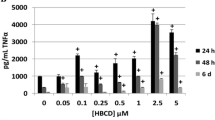Abstract
Treosulfan and busulphan are similar molecules, the former used in the treatment of ovarian cancer and the latter in chronic myelogenous leukaemia. We have used both in the differential staining cytotoxicity (DiSC) assay forin vitro drug sensitivity testing to aid in the choice of chemotherapy for individual patients.
It was observed that occasionally the viability of control cells in one assay box was reduced compared with control cells in other boxes from the same assay. Treosulfan was suspected as the cause because cells throughout the microtitre box containing treosulfan had reduced viability in 28/62 (45%) experiments and in 9 of these, total kill of all cells in the box was observed.
We tested the hypothesis that a metabolite of treosulfan might be the cause of this airborne cytotoxicity, and found that whilst 10 mg ml−1 of either methane sulphonic acid or tetrahydrofuran had no airborne cytotoxic effect, 1 mg ml−1 diepoxybutane killed over 95% of cells in all tubes in the same box.
Treosulfan is another chemical (cf. azide, mafosfamide and possibly other cytotoxic agents) that can cause airborne cytotoxicity.
Similar content being viewed by others
Abbreviations
- ALL:
-
acute lymphoblastic leukaemia
- AML:
-
acute non-lymphocytic leukaemia
- CLL:
-
chronic lymphocytic leukaemia
- NHL:
-
non-Hodgkin's lymphoma
- DiSC assay:
-
differential staining cytotoxicity assay
- MTT assay:
-
3-(4,5-dimethylthiazol-2-yl)-2,5-diphenyl tetrazolium bromide assay
- PBS:
-
phosphate buffered saline
References
Bird MC, Bosanquet AG, Forskitt S and Gilby ED (1986) Semimicro adaptation of a 4-day differential staining cytotoxicity (DiSC) assay for determing thein vitro chemosensitivity of haematological malignancies. Leuk. Res. 10:445–449.
Blomgren H and Hallström M (1989) Release of a volatile factor from solutions of oxazaphosphorines which damage normal and malignant cells. Meth. Find. Exp. Clin. Pharmacol. 11:391–397.
Bosanquet AG (1991) Correlations between therapeutic response of leukaemias andin vitro drug-sensitivity assay. Lancet 337: 711–714.
Bosanquet AG (1993)In vitro drug sensitivity testing for the individual patient: an ideal adjunct to current methods of treatment choice. Clin. Oncol. 5:195–197.
Bosanquet AG (1994) Short-termin vitro drug sensitivity tests for cancer chemotherapy. A summary of correlations of test result with both patient response and survival. Forum Trends Exp. Clin. Med. 4:42–58.
Boullier AB and Bosanquet AG (1990) Reduced cell viabilityin vitro following exposure to a routine laboratory disinfectant. Cytotechnology 4:109–110.
Copelan EA (1992) Conditioning regimens for allogenic bone marrow transplantation. Hematol. Oncol. 6:234–242.
Feit PW and Rastrup-Anderson N (1973) 4-Methanesulfonyloxybutanol: Hydrolysis of Busulfan. J. Pharm. Sci. 62:1007–1008.
Feit PW, Rastrup-Anderson N and Matagne R (1970) Studies on epoxide formation from (2S,3S)-threitol 1,4-bismethanesulfonate. The preparation and biological activity of (2S,3S)-1,2-epoxy-3,4-butanediol 4-methanesulfonate. J. Med. Chem. 13:1173–1175.
Fruehauf JP and Bosanquet AG (1993)In vitro determination of drug response: a discussion of clinical applications. In: DeVita VT, Hellman S and Rosenberg SA (eds), Cancer Principals and Practice of Oncology, PPO updates. Philadelphia Lippincott. Vol 7 (Part 12):1–16.
Hassan M and Ehrsson H (1986) Degradation of busulfan in aqueous solution. J. Pharm. Biomed. Anal. 4:95–101.
Koeffler HP and Golde DW (1990) Chronic Myelogenous Leukemia. In: Haskell CM (ed), Cancer Treatment. 3rd Edition. Philadelphia: Saunders. pp. 620–627.
Lelieveld P, Aapro MS, van Lambalgen R and van den Berg KG (1986) Sodium azide is less suitable as a positive control of drug-induced lethality forin vitro clonogenic assays. Invest New Drugs 4:367–371.
Masding J, Sarkar TK, White WF, Barley VL, Chawla SL, Rostom AY and Menday AP (1990) Intravenous treosulfan versus intravenous treosulfan plus cisplatinum in advanced ovarian carcinoma. Br. J. Obstet. Gynaecol. 97:342–351.
Wilson JK, Sargent JM, Elgie AW, Hill JG and Taylor CG (1990) A feasibility study of the MTT assay for chemosensitivity testing in ovarian malignancy. Br. J. Cancer 62:189–194.
Author information
Authors and Affiliations
Rights and permissions
About this article
Cite this article
Bosanquet, A.G., Burlton, A.R. Airborne cytotoxicity in the DiSC assay caused by solutions of treosulfan but not busulphan. Cytotechnology 16, 131–136 (1994). https://doi.org/10.1007/BF00754615
Received:
Accepted:
Issue Date:
DOI: https://doi.org/10.1007/BF00754615



